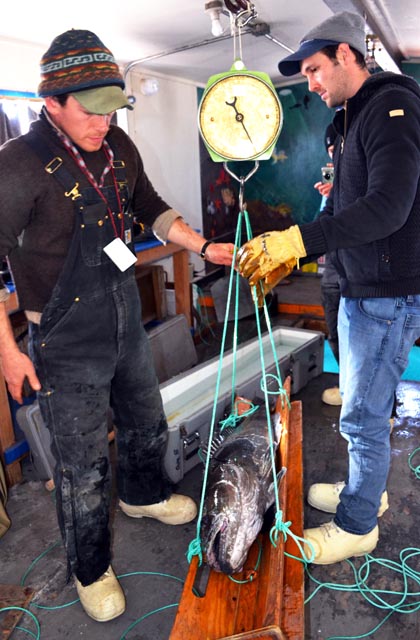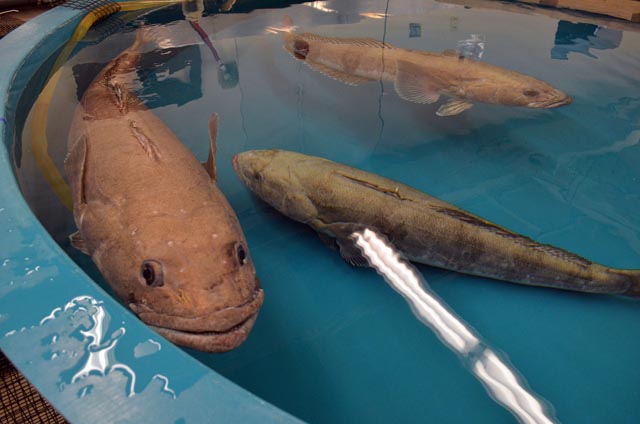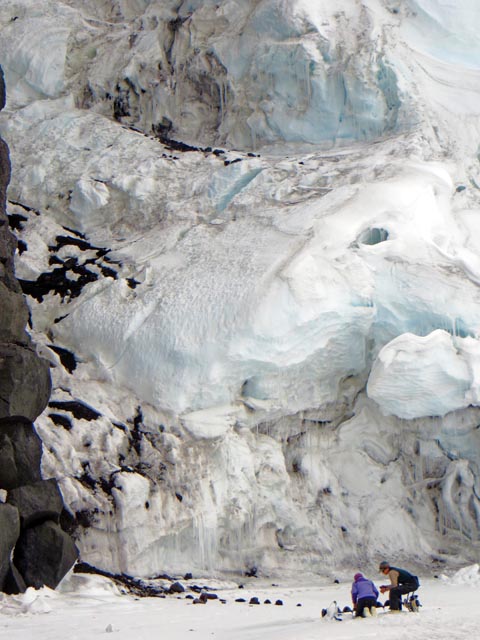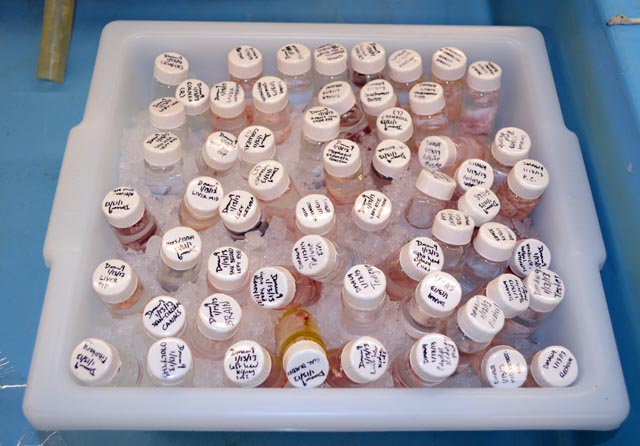|
Growing coldScientists study broad adaptations of Antarctic fish to freezing watersPosted July 5, 2013
The aquarium tanks in McMurdo Station’s The Antarctic toothfish, one of the largest of the 120-plus species that make up the group of fish known collectively as notothenioids Perhaps the most well-known and intensely studied trait is the ability of these fish to produce a sort of antifreeze protein that binds to ice crystals in the body to prevent them from growing. Otherwise, the fish would quickly freeze and die in seawater as cold as minus 1.8 degrees Celsius. 
Photo Courtesy: Paul Cziko
Scientists Paul Cziko, left, and Konrad Meister weigh an Antarctic toothfish in the field.
The sheer size of Antarctic toothfish, which can tip the scale at nearly 150 kilograms, makes it an ideal candidate for researchers who need tissue and blood samples for various analyses, some studies delving deep into the organism’s cell biology, as they attempt to learn more about how mawsoni and its cousins function in the world's coldest waters. “You can actually get fluids from tiny little ducts and canals from the mawsoni that you can’t get from the smaller fish,” explained Paul Cziko “We use the mawsoni a lot because it gives you a lot of material,” noted Christina Cheng “It’s a precarious kind of existence,” Cheng said. The first insights into how notothenioids cope with cold conditions came back in the 1960s, largely through research by Art DeVries Since then — and thanks to the genomic The adaptation didn’t emerge until relatively recently, somewhere around 20 million years ago, after Antarctica turned into an icehouse. Cheng’s recent research revealed that the antifreeze protein evolved from a small bit of DNA that was attached to another gene, which was a digestive enzyme. “That piece got duplicated and duplicated and duplicated — maybe changed a little bit — and made this really long repetitive gene that codes for protein and made this antifreeze protein,” Cziko explained. “It was a completely new invention.” “Here we actually see how the evolution of a single protein contributes to survival of a species or a whole clade of these organisms,” he added. Thanks to the antifreeze protein and other adaptations — such as the ability to maintain neutral buoyancy despite the absence of a swim bladder — the notothenioids filled many of the ecological niches left vacant by those less suited for frigid Southern Ocean. Deoxyribonucleic acid The order of the bases determines the meaning of the information encoded in that part of the DNA molecule, just as the order of letters determines the meaning of a word. An organism’s complete set of DNA is called its genome. Cheng began her molecular and genomic research after working with a student who sequenced the first antifreeze protein gene. Sequencing “I found that sort of thing very interesting. I sort of taught myself molecular biology after the student left,” she said. The team has since sequenced the entire genome of the Antarctic toothfish. Now Cheng wants to look more broadly at the adaptations that mawsoni and other fish of its ilk in the Southern Ocean possess that allow them to function at nearly minus 2 degrees Celsius. To figure that out, she and her group need more tissue samples from the Antarctic toothfish, as well as from a non-Antarctic species of Notothenioidei, Eleginops maclovinus, which is as closely related to the mawsoni as possible but without the antifreeze protein or evolutionary cold adaptation. “This whole genome study is to try to figure out what are these changes in all of the proteins that are needed for everything — from growth, development, reproduction, metabolic functions, energy production. Everything,” Cheng said. “There has to be something that is different so they can work at this low temperature.” |



For USAP Participants |
For The Public |
For Researchers and EducatorsContact UsNational Science FoundationOffice of Polar Programs Geosciences Directorate 2415 Eisenhower Avenue, Suite W7100 Alexandria, VA 22314 Sign up for the NSF Office of Polar Programs newsletter and events. Feedback Form |




